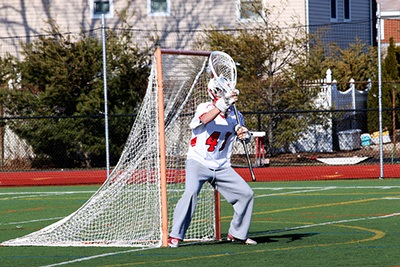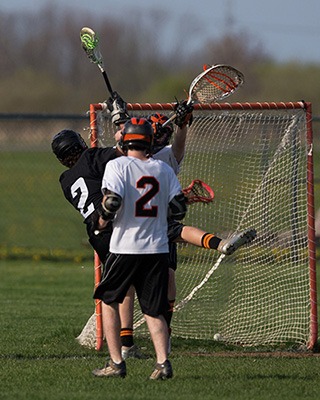Are you a lacrosse player or coach looking to help your team succeed? If so, you know how crucial it is to have the right equipment.
When it comes to goalie lacrosse heads, stringing can make all the difference when trying to stop goals from hitting the back of the net.
That's why we're here today:
To give you some invaluable best practices and tips on how to string a goalie lacrosse head!
So read on for our ultimate guide on how to master this skill set and get your team ready for victory.
More...
Take Away Key Points:
How to String a Lacrosse Goalie Head? A Complete Procedure
If a lacrosse goalie is your target position, stringing a lacrosse goalie head is your first step toward the goal.
So, if you struggle to achieve it, here are the guidelines to guide you through the stringing process.
Step 1: Gathering the equipment for a lacrosse goalie stick
Before you start stringing a lacrosse goalie head, you will need the proper lacrosse equipment. These include:
- a goalie net: you can choose from twelve-diamond, ten-diamond mesh, or twenty-diamond goalie mesh.
- sidewall strings
- shooting strings
- a knife or scissors
- a lighter
You may want to precut the shooting and sidewall strings before stringing a goalie pocket to ensure you don't work with a large spool. This will make the procedure smooth and quick.
Step 2: Spreading the mesh holes

Grab each mesh side and spread the mesh holes. Perform this step for the entire mesh, from the top to the bottom part.
Mesh should be loose and nice, all the way down, to form a nice deep pocket later.
Step 3: Folding the top two rows of diamonds together
Fold the first two rows of diamonds, and place the lacrosse mesh against the lacrosse stick. The rough side of the mesh should touch the lacrosse ball.
Conversely, the smooth side of the lacrosse mesh should go back on the back of the stick.
Step 4: Stringing the top string in the center
You should fold the top string in half, putting two ends together. Take them and place them in the center position of the mesh hole.
Enter from the front side of the goalie head, and go through the top center of the goalie mesh hole.
Next, pull both ends back through the top string (the loop). Ensure both the knot and the mesh are centered. Next, pull that string tight to create your first knot.
Step 5: Stringing the top string from the center
The next step is to string the lacrosse goalie stick from the center to the side. The method below explains how to string each hole.
First, you will take the top string and go through the back of the next hole on your stick. Next, pull the top string through the other hole. Next, you will tie the knot tight.
Finally, you will go through the same hole and then back through the hole, entering on the front side of the lacrosse goalie head.
Then, you should pull the string through the created loop and pull it tight. As you're stringing, continue to pull the knots tight.
Repeat the procedure until the top hole of the goalie lacrosse head and all holes are strung tight. However, you must string from the center of the pocket.
Step 6: Securing the top corner

The next step is to secure the corners. This step is critical to increasing ball control. This way, the ball won't hit the plastic when you throw it during the play.
The first step is to place the top string through the end mesh hole. From that point, the string goes through the goalie lacrosse head hole. Pull the string tight.
Next, you take the corner piece of mesh and loop it over the stick head. The next step is coming down with the string and going through the goalie mesh hole.
Finally, you should pull the string back through the next low hole on the lacrosse goalie head. Ensure you tie the string tight to create a tight knot. Once you tie a tight knot, tie another one (double knot). Thus, the string won't pull through the hole. You should repeat the same step on the other side of the lacrosse goalie head.
Step 7: Stringing the sidewalls
Once the top of the goalie stick is done, you should string the sidewall holes.
You can start with a double knot on the sidewall string. Pull the sidewall string tight through the first goalie sidewall hole. The knot will be on the outside of the lacrosse goalie head.
Next, you should place the end of the sidewall string through the hole and pull it through the next lowest goalie head row. Take the string's end and pull it through the next lowest lacrosse head hole. While stretching the netting, it will be firm against the sidewall.
Repeat the process down the goalie stick. For the first and third holes, your string should be as firm as possible. For the remaining sidewall holes, the tightness doesn't have to be that firm. This will help create a nice pocket a lot smoother.
Once you're done with sidewall holes, place the string through the next net hole and then again through the next row.
In addition, place the string through the top of the goalie pocket. Tighten it, and create double knots. Perform the same process on another side of the lacrosse goalie head.
Step 8: Forming the channel with a lacrosse ball
After completing the sidewall design, you should start forming the lacrosse pocket. Finally, you can place the ball in the pocket to loosen the net.
You should perform the step up and down the pocket on the front side of the goalie pocket and then flip the lacrosse goalie stick over to repeat the procedure on the back side of the lacrosse goalie pocket.
Other tips include putting the netting into hot water, using fabric softener or even your fist to loosen the net, and making sufficient pocket depth.
Step 9: Stringing the bottom string
To string the bottom string successfully, you can also use the shooting strings.
Applying the shooting string, go through the bottom hole below the shooting strings and up through the throat of the lacrosse stick. Fastening the end with a double knot is critical to hold the lacrosse goalie head stable.
Place the shooting string into the slack you last used on the string of sidewalls. Weave it all the way across. Then, place the shooting string back through the throat and bottom holes.
Wait a bit to knot off the string and make the twist knot. The procedure includes the shooting string into its bottom hole, fastening it off with dual knots, and pulling it firm.
Next, you should place the sidewalls into the same slack the shooting string is in. The string will be firm, and you need a knife to get the string down.
Find the central three diamonds and bring the strings through. Start tying at the central three slacks. In addition, the kinked end of the string around will also do a small weaving. You can perform the step twice if you like.
You will return to the other slack and redo the step above from the bottom. Before unfastening the strings, you should punch the pocket out. Fasten the shooting and sidewalls with double knots for a correct pocket depth and legal game.
Step 11: Attaching shooting strings
There are multiple methods to attach shooting strings. They keep the top of the mesh stiff to help in throwing balls and better stick and ball control.
Putting the string through the sidewall is your starting point step. Next, weave the string through the mesh. Find the same sidewall slack on the opposite side of the stick and place the string through.
Next off, you should fasten the string back across, pull it firmly, and then fasten it with dual knots. Repeat the steps for every shooting string used for the lacrosse goalie head.
When going lower, the head and strings should be less firm. The firmest string should be on the top; otherwise, the goalie head and stick won't throw the balls correctly. In addition, they will cause an unnecessary whip.
Quad Sidewall Lacrosse Goalie Stringing

Quad sidewall goalie stringing is a specific form of lacrosse goalie heads.
It involves weaving four strings around each side of the lacrosse goalie heads to make a unique pocket pattern that offers maximum control, precision, and accuracy for goaltenders.
The process begins with selecting the type of strings that will be used.
These strings usually come in materials such as String King's grizzly netting though some may opt for hand netting or traditional nylon pockets.
Once the type has been determined, the appropriate slacks must be drilled into the posts, allowing the sidewalls to be securely attached.
From there, each side is woven diagonally through the other while making sure that all knots are tight and evenly spaced.
Finally, after carefully inspecting all sides of the lacrosse head to make sure it is adequately strung up, it is ready to take to the field!
Frequently Asked Questions
Is soft or hard mesh better for a goalie head?
A hard type is better for a lacrosse goalie head.
Hard netting is durable, easier to string, and maintains a proper channel and shape of the pocket better than wax or soft net.
How often should you replace your goalie head?
You should replace your lacrosse goalie head at the start of each lacrosse season. If you're an aggressive player, you might need a couple of heads.
Conclusion
Overall, stringing a lacrosse goalie's head can be challenging, but with the proper knowledge and techniques, it can easily be mastered.
It is essential to ensure you follow the rules on how to string a goalie lacrosse head, as any violations could result in costly penalties during the game.
So take your time, research as needed, and practice different techniques until you get it right!
